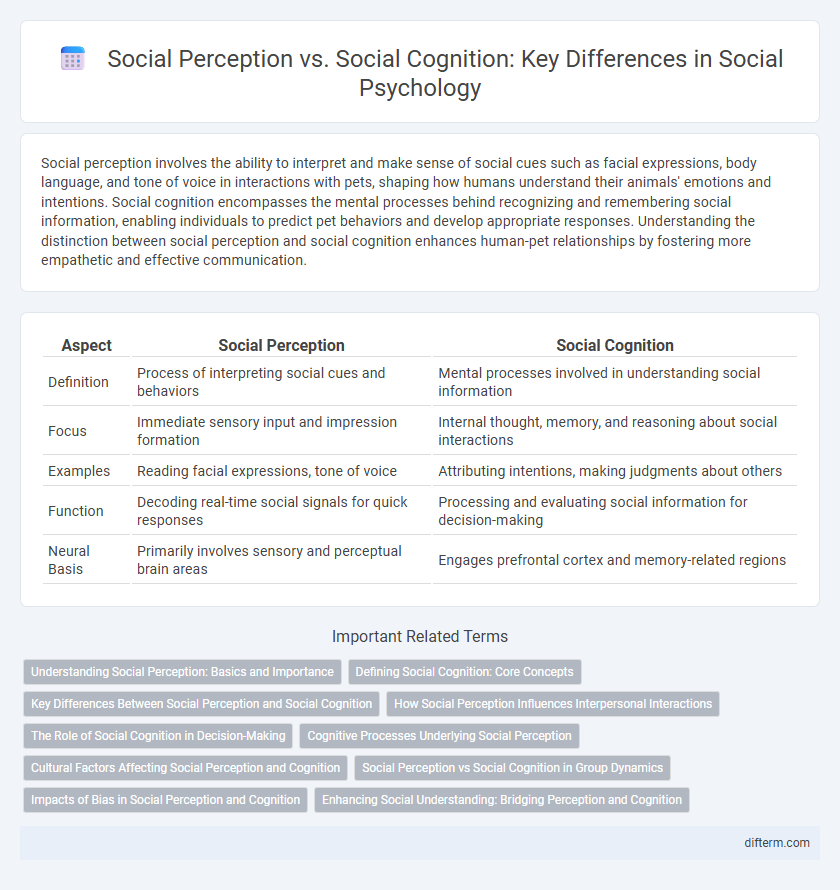Social perception involves the ability to interpret and make sense of social cues such as facial expressions, body language, and tone of voice in interactions with pets, shaping how humans understand their animals' emotions and intentions. Social cognition encompasses the mental processes behind recognizing and remembering social information, enabling individuals to predict pet behaviors and develop appropriate responses. Understanding the distinction between social perception and social cognition enhances human-pet relationships by fostering more empathetic and effective communication.
Table of Comparison
| Aspect | Social Perception | Social Cognition |
|---|---|---|
| Definition | Process of interpreting social cues and behaviors | Mental processes involved in understanding social information |
| Focus | Immediate sensory input and impression formation | Internal thought, memory, and reasoning about social interactions |
| Examples | Reading facial expressions, tone of voice | Attributing intentions, making judgments about others |
| Function | Decoding real-time social signals for quick responses | Processing and evaluating social information for decision-making |
| Neural Basis | Primarily involves sensory and perceptual brain areas | Engages prefrontal cortex and memory-related regions |
Understanding Social Perception: Basics and Importance
Social perception involves interpreting and understanding others' behaviors, emotions, and intentions through nonverbal cues and contextual information. It plays a critical role in forming first impressions and influences interpersonal interactions by shaping how we interpret social signals. Mastery of social perception enhances empathy and effective communication, laying the foundation for complex social cognition processes.
Defining Social Cognition: Core Concepts
Social cognition involves the mental processes used to perceive, interpret, and respond to social information, including understanding intentions, emotions, and behaviors of others. It encompasses core concepts such as theory of mind, social memory, and emotion recognition, which are essential for effective interpersonal interactions. Unlike social perception, which emphasizes immediate interpretation of social cues, social cognition integrates past experiences and contextual information to guide social decision-making and behavior.
Key Differences Between Social Perception and Social Cognition
Social perception involves the immediate process of interpreting and understanding social cues such as facial expressions, body language, and tone of voice, crucial for real-time interactions. Social cognition encompasses higher-level mental processes, including forming impressions, attributing intentions, and predicting behavior based on social information. Key differences lie in social perception's focus on direct sensory input and social cognition's reliance on complex reasoning and memory integration to navigate social environments.
How Social Perception Influences Interpersonal Interactions
Social perception shapes interpersonal interactions by influencing how individuals interpret others' emotions, intentions, and behaviors, which guides responses and communication styles. Accurate social perception fosters empathy and trust, enhancing relationship quality and cooperation in social settings. Misinterpretations or biases in social perception can lead to misunderstandings, conflict, and diminished social cohesion.
The Role of Social Cognition in Decision-Making
Social cognition plays a crucial role in decision-making by enabling individuals to interpret, analyze, and predict the behaviors and intentions of others based on social cues. This cognitive process involves recognizing emotions, processing social information, and applying learned social norms to evaluate potential outcomes. Effective social cognition enhances the accuracy of judgments and supports adaptive decision-making in complex social environments.
Cognitive Processes Underlying Social Perception
Social perception involves the initial encoding and interpretation of social stimuli, relying heavily on attention and memory processes to identify and categorize others' behaviors and intentions. Social cognition encompasses a broader range of cognitive processes, including attribution, theory of mind, and inference-making, which enable individuals to understand and predict others' mental states. Neural mechanisms such as the prefrontal cortex and amygdala play critical roles in underlying these cognitive processes, facilitating the accurate processing and integration of social information.
Cultural Factors Affecting Social Perception and Cognition
Cultural factors significantly impact social perception and cognition by shaping how individuals interpret social cues and process information about others. Differences in cultural norms, values, and communication styles influence attention, memory, and categorization of social information, affecting overall social understanding. Cross-cultural research highlights variations in collectivist versus individualist orientations, which alter social perception biases and cognitive frameworks across societies.
Social Perception vs Social Cognition in Group Dynamics
Social perception involves the initial interpretation of others' behaviors and nonverbal cues in group dynamics, shaping first impressions within social settings. Social cognition encompasses deeper processes such as attributing intentions, understanding group roles, and predicting behavior, crucial for effective group coordination and conflict resolution. Together, these mechanisms influence how individuals navigate social hierarchies and establish trust in collective environments.
Impacts of Bias in Social Perception and Cognition
Bias in social perception distorts the accuracy of interpreting others' behaviors, leading to stereotyping and misjudgments that affect interpersonal relationships. Social cognition bias influences decision-making and memory, often reinforcing prejudiced attitudes and social inequalities. Understanding these impacts is crucial for developing interventions that promote fairness and reduce discrimination in social interactions.
Enhancing Social Understanding: Bridging Perception and Cognition
Social perception involves interpreting external social cues such as facial expressions, body language, and tone of voice to gain immediate understanding of others' emotions and intentions. Social cognition encompasses the mental processes used to interpret, analyze, and predict social behavior based on these perceptions, including theory of mind and empathy. Enhancing social understanding requires integrating accurate social perception with complex social cognitive functions to improve interpersonal communication and relationship-building.
social perception vs social cognition Infographic

 difterm.com
difterm.com